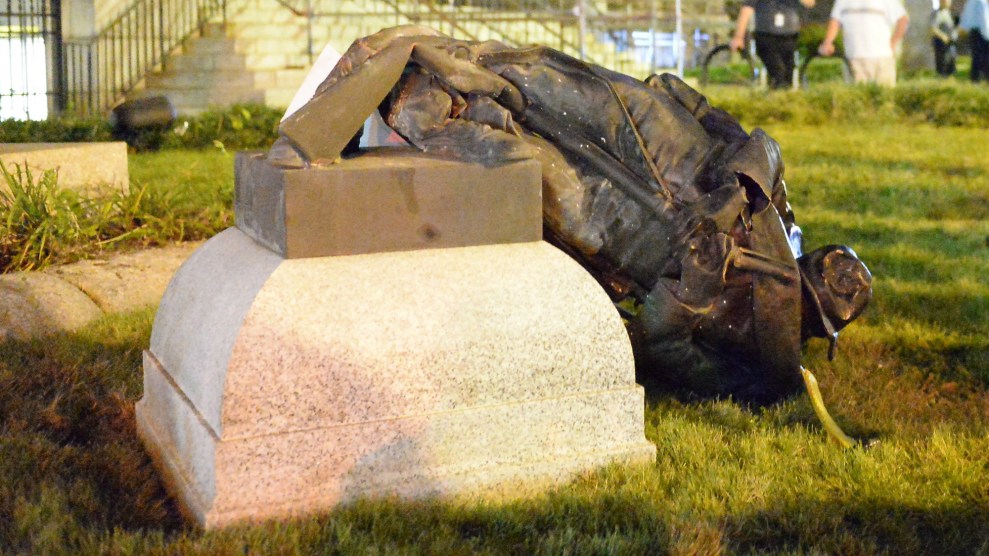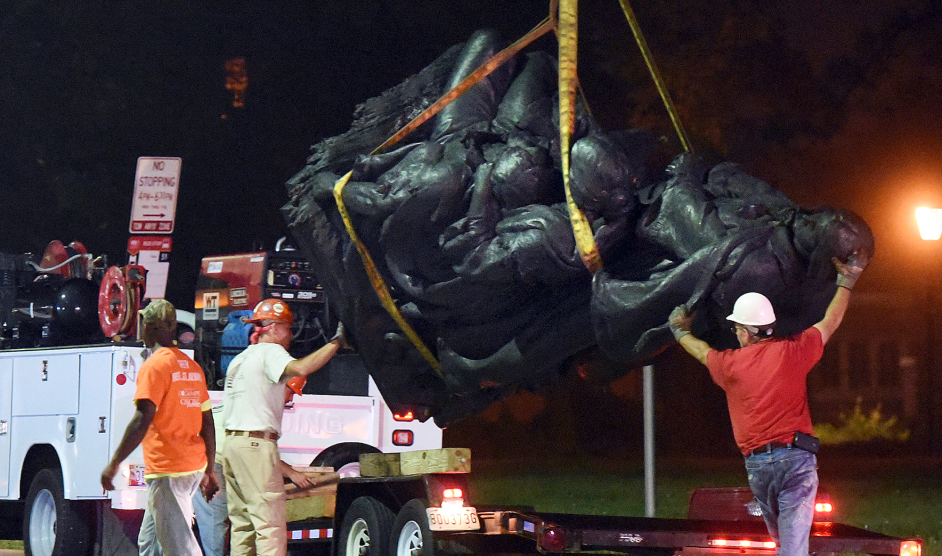
A protester kicks the toppled statue of a Confederate soldier after it was pulled down in Durham, N.C. Monday, Aug. 14, 2017. Activists used a rope to pull down the monument outside a Durham courthouse. Casey Toth/The Herald-Sun via AP
This past weekend’s violent protests against the planned removal of a Charlottesville, Virginia, monument commemorating Robert E. Lee by “alt-right” activists and white supremacists—and the counter-protests that opposed those demonstrations—has captured the attention of the entire country. But the effort to take down the symbols that glorify the Confederacy and its leaders are far from new. The tensions in Charlottesville build on a movement that surged after a white supremacist killed nine parishioners at a historically black church in Charleston, S.C. in 2015. Beyond monuments, the debate has focused on flags like that of Mississippi, which bears the Confederate flag as part of its design, as well as on schools and streets with names that bear Confederate connotation. On Thursday morning, Trump threw fuel on the fire by tweeting his support for keeping Confederate monuments in place around the country.
Sad to see the history and culture of our great country being ripped apart with the removal of our beautiful statues and monuments. You…..
— Donald J. Trump (@realDonaldTrump) August 17, 2017
…can't change history, but you can learn from it. Robert E Lee, Stonewall Jackson – who's next, Washington, Jefferson? So foolish! Also…
— Donald J. Trump (@realDonaldTrump) August 17, 2017
…the beauty that is being taken out of our cities, towns and parks will be greatly missed and never able to be comparably replaced!
— Donald J. Trump (@realDonaldTrump) August 17, 2017
In the aftermath of Charlottesville, numerous cities are grappling with their Confederate symbols, sometimes in the dead of night. Here, we’ve gathered some of the other places that have seen disputes over symbols honoring the Confederate past—a number of which, interestingly enough, actually lie outside the heart of the Confederacy.
Alabama
In the wake of New Orleans’ monument removals (more on that below), Republican Alabama Gov. Kay Ivey took steps in the opposite direction: In May, she signed a law that prohibits the removal or alteration of public monuments that are more than 40 years old. State senator Gerald Allen (R-Tuscaloosa), the bill’s sponsor, said in an interview with CNN that the legislation aims to preserve “the good, bad, and ugly” of the state’s history. Alabama Democrats argue that it puts the Confederacy on a pedestal.
Earlier this week, city workers in Birmingham used wooden panels to cover a memorial to Confederate soldiers and sailors, dedicated in 1905 by the Daughters of the Confederacy, in a downtown park. On Wednesday, Alabama’s attorney general sued the city and its mayor, saying that the panels were an illegal means to circumvent the new law.
Arizona
Wait, Arizona? Yes. On Monday, Republican Gov. Doug Ducey rebuffed requests by African-American civil rights groups in the state to remove monuments to the Confederacy on public lands, such as a memorial placed by the Daughters of the Confederacy across from the Arizona capitol and a road marker for Jefferson Davis Highway. Civil rights leaders protested his decision, likening it to Trump’s equivocal response to Charlottesville. “A number of us have received death threats in regards to our position,” East Valley NAACP President Roy Tatem said during a protest at the state capitol Tuesday. “This isn’t the time to play those kinds of politics.” Arizona had some sporadic fighting as a contested territory in the Civil War but did not become a state for another 50 years; most of its monuments date to the mid-20th century.
Meanwhile, on Thursday a monument to Jefferson Davis located in Gold Canyon, Ariz., just off a major highway, was tarred and feathered. Literally. The monument is, when it’s not covered in debris, a simple stone plaque that bears the name of the former president of the Confederate States.
Closeup of tar and feathers on vandalized Jefferson Davis Confederate monument east of Phoenix. #Fox10Phoenix pic.twitter.com/7ltfxYPyPB
— Steve Krafft (@stevekrafft7) August 17, 2017
California
In Los Angeles early Wednesday morning, owners of the Hollywood Forever Cemetery removed a Confederate memorial and put it in storage for the foreseeable future. The memorial was erected in 1925 by the Long Beach chapter of the Daughters of the Confederacy to honor the 30-some Confederate soldiers buried at the cemetery, which is best known for its numerous celebrity graves. While owners of the cemetery received many calls urging them to remove the marker after Saturday’s events in Charlottesville, it ultimately came down at the behest of the group that sponsored it. “All we wanted was peace, quiet as we had for many years,” a representative for the Daughters told KPCC.
Florida
Community groups in Tampa have ardently advocated for the removal of a Confederate statue outside the Hillsborough County courthouse. But in June, county commissioners voted 4 to 3 to keep it in place. At its 1911 unveiling, a state attorney approvingly boasted that the monument would send a message that the “South detests and despises all, it matters not from whence they came, who, in any manner, encourages social equality with an ignorant and inferior race.” Instead of removing the statue, the county will pay for a mural behind the monument to display the “love and diversity” in Hillsborough County.
In July in Orlando, a city only incorporated 10 years after the end of the Civil War, a 1911 statue known as “Johnny Reb” and commissioned by the Daughters of the Confederacy was removed from its spot in a downtown park and moved to a cemetery. (The term “Johnny Reb” is used as slang for Confederate soldiers and has taken on a sort of national personification of the Confederacy.) The action came at the direction of Mayor Buddy Dyer, a Democrat. During the city hall meeting in which the decision was made for removal, many protesters entered the chambers wearing Confederate flags on T-shirts and hats; one man showed up in a Civil War Confederacy uniform.
On Monday of this week, Jacksonville city council president Anna Lopez Brosche announced that the city intends to remove its Confederate statues and memorials from city property and place them in a museum. On the same day, city workers in Gainesville removed a 1904 monument near the University of Florida campus called “Old Joe.” It was returned to the Daughters of the Confederacy and moved to a private cemetery outside of the city. The city’s next move could be to put up a memorial to victims of lynching.
"Old Joe" #Confederate statue in Gainesville being removed just days after #charlottsville pic.twitter.com/A2iAWr8lra
— Andrew Caplan (@AACaplan) August 14, 2017
Georgia
A massive carving that depicts the faces of Jefferson Davis, Robert E. Lee, and Stonewall Jackson on horseback has been on the side of Stone Mountain in Georgia since 1915 (the state purchased the property in 1958). Now, Democratic gubernatorial candidate Stacey Abrams is calling for its removal.
But the visible image of Stone Mountain's edifice remains a blight on our state and should be removed. /6
— Stacey Abrams (@staceyabrams) August 15, 2017
According to the Atlanta Journal-Constitution, removing those faces would require a change in state law—the Georgia state code says the memorial should be “preserved and protected for all time as a tribute to the bravery and heroism of the citizens of this state who suffered and died in their cause.” For years, civil rights leaders have been calling for the etching to be erased.
Louisiana
This past spring, New Orleans city crews who’d been tasked with taking down a series of monuments to the Confederacy and to a Reconstruction-era white supremacist militia required the protection of armed guards while they did their work. The removal of the monuments, which were erected in the early 20th century, was backed by Democratic Mayor Mitch Landrieu and the city council, following years of contentious lawsuits and armed demonstrations. After the statues’ removal, Landrieu gave a powerful, widely lauded speech on race:
Massachusetts
A confederate monument in Yankeeland? That’s right. Erected in 1963 by the Daughters of the Confederacy, the memorial has been boarded up since June as state officials decide what to do with it. The memorial—a granite slab with an engraving that commemorates “more than a thousand Confederates that were imprisoned” at the site—sits on Fort Warren in the Boston Harbor. The stalled efforts for removal are a result of Fort Warren’s designation as a national historic landmark. On Tuesday, the office of Republican Governor Charlie Baker issued a statement saying he “believes we should refrain from the display of symbols, especially in our public parks, that do not support liberty and equality for the people of Massachusetts.” The future of the memorial is presently unclear.
Maryland
Residents of Baltimore, a majority-black city, woke up Wednesday morning to find that the city’s Democratic mayor Catherine Pugh had four confederate monuments removed overnight. The memorials were taken down between the hours of 11:30 pm Tuesday and 5:30 am Wednesday—among them a monument to Robert E. Lee and Stonewall Jackson, erected in 1948, Supreme Court justice Robert B. Taney, who authored the Dred Scott opinion, erected in 1887, and two others erected in 1903 and 1917. Pugh said the city’s goal in scheduling the removal during the dead of night was to move “quickly and quietly,” in the hopes of avoiding potentially violent clashes between residents in the wake of Saturday’s events in Charlottesville.
They rode in on the Lost Cause. They rode out on a flatbed truck. pic.twitter.com/CfRlluk5s0
— Alec MacGillis (@AlecMacGillis) August 16, 2017
On Wednesday, activists placed a protest statue of a pregnant woman with a child on her back, titled “Madre Luz” and created by a local artist, in the spot where a Confederate monument formerly stood. On Thursday afternoon, it was found broken and vandalized, with the words “HONOR HISTORY” painted underneath.
Breaking: controversial statue placed by activists in Baltimore to celebrate confederate monument removal apparently vandalized. @wusa9 pic.twitter.com/mnIEM2Ozi3
— Scott Broom (@scottbroom) August 17, 2017
Then in Annapolis on Tuesday, Republican Governor Larry Hogan called for the removal of another statue of Taney, this one on the front lawn of the State House. On Wednesday, the Maryland State House Trust voted to remove it. Maryland was a slave state that stayed in the union, albeit partly under martial law.
New York
In Brooklyn, a plaque that demarcated a tree planted by Robert E. Lee before the Civil War was removed by Episcopalian and Lutheran leaders on Tuesday because of the violence in Charlottesville. A marker installed next to the plaque by the Daughters of the Confederacy was also removed. The bishop of the Episcopal Diocese of Long Island told the New York Post that they were quickly overwhelmed with threatening phone calls and emails. “We need to be on the right side of history and send a very clear message, during this climate of hate and racism in our country,” Rev. Khader El-Yateem, a Lutheran pastor who helped remove the plaques, told the Post. “We are sending a message that we will not stand on the side of racism and hate.”
North Carolina
Protesters in Durham stormed the county courthouse on Monday and took down a 1924 monument to Confederate soldiers. As of Thursday afternoon, at least eight people had been arrested by Durham County police in connection with the protest and removal, with charges including destruction of property, disorderly conduct, and inciting a riot. Takiyah Thompson, the 22-year-old activist who was the first to be arrested after speaking at a press conference on her college campus, has been hailed as a hero for tying the rope that brought the statue down. In solidarity, residents showed up in droves to the county detention facility Thursday morning to, they said, turn themselves in. (Read more about the situation in Durham here.)
MORE: Protestors rip down statue of Confederate soldier. Monument has stood since in @DurhamCounty since 1924. @ABC11_WTVD pic.twitter.com/4MjFXsxS18
— Jonah Kaplan (@KaplanABC11) August 14, 2017
Tennessee
In Memphis, a majority-Black city, following the 2015 mass shooting in Charleston, S.C., the phrase “Black Lives Matter” was spray painted on the base of a 1905 monument to Nathan Bedford Forrest, the Confederate general and slave trader who later became the first KKK grand wizard. A few weeks later, the city council voted to remove the statue. But in 2016, the Tennessee Historical Commission (THC) denied the request based on criteria they had set forth for statue removal in 2015. (The remains of Forrest and his wife are also interred at the site.) The Memphis debate resurfaced on Sunday, when Democratic Mayor Jim Strickland took to Twitter to condemn white supremacists and evoked the city’s ongoing efforts to remove its confederate statues. The city council will take their request to the THC again in October.
Meanwhile, in Nashville on Monday, demonstrators flooded the Tennessee state capitol to demand the removal of a bust of Forrest. Republican Gov. Bill Haslam issued a statement asking the THC to have it removed. But that will be easier said than done; last year, the Republican state legislature passed an update to a law specifically designed to prevent cities and counties from removing Confederate monuments, such as the Forrest bust.
Office of @BillHaslam releases statement as protesters sit outside his door. pic.twitter.com/6SQ1QvpO0Q
— Blake Farmer (@flakebarmer) August 14, 2017
Texas
Last month two San Antonio city council members and a racial justice group called SATX4 pushed to relocate a 40-foot tall monument of an anonymous Confederate soldier, erected by the Daughters of the Confederacy in 1899, to a museum. On Saturday, coinciding with the events in Charlottesville, opposing groups of demonstrators rallied in a San Antonio park—some to call for the removal of the monument, some to defend its presence. Hundreds of members of a group that calls itself This Is Texas Freedom Force (TITF)—“protectors of all things Texas”—and other “alt-right” organizations, stood on one side of the park carrying semi-automatic rifles and confederate flags in protest of the proposed removal. Members of SATX4 and affiliated groups stood on the other side, where one activist was arrested. “At any type of rally we hold, we always encourage people to bring their rifles,” a TITFF leader told the Texas Observer. Texas is an open carry state.
SAVE THE MONUMENT RALLY in San Antonio, Tx. Thank you to all the Texans that showed up to fight the good fight! pic.twitter.com/e5ScaBIWD3
— This Is Texas Freedom Force (@ThisIsTexasFF) August 14, 2017
Then this week, in response to calls from groups in Houston to remove a 1908 “Spirit of the Confederacy” monument in the city’s downtown, Democratic Mayor Sylvester Turner authorized a review of all the city’s confederate monuments.
Washington, D.C.
In the National Statuary Hall Collection in the U.S. Capitol, there are at least 12 Confederate statues. Late Wednesday, Sen. Cory Booker (D-N.J.) announced he’d be introducing legislation to remove those Confederate memorials from the building.
I will be introducing a bill to remove Confederate statues from the US Capitol building. This is just one step. We have much work to do.
— Cory Booker (@CoryBooker) August 17, 2017
The next morning, House Minority Leader Nancy Pelosi called the Confederate statues in the Capitol “reprehensible” and echoed Booker’s call for their removal. “If Republicans are serious about rejecting white supremacy,” Pelosi said, “I call upon Speaker Ryan to join Democrats to remove the Confederate statues from the Capitol immediately.”
West Virginia
On Sunday, demonstrators in Charleston called for the removal of a statue of Stonewall Jackson from the lawn of the state Capitol building. Protesters were gathered for what ended up being a relatively uneventful two hours, though Capitol police, Charleston police, and West Virginia state police were all present. The crowd was met with a few counter-protesters who said taking down the statue, erected in 1910, would be “destroying history.” During the Civil War, delegates from the region that now makes up the state opposed Virginia’s secession from the Union and West Virginia later seceded from the Confederacy.
















